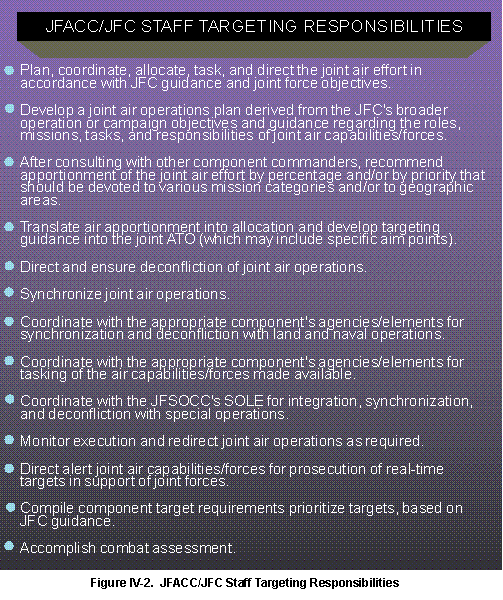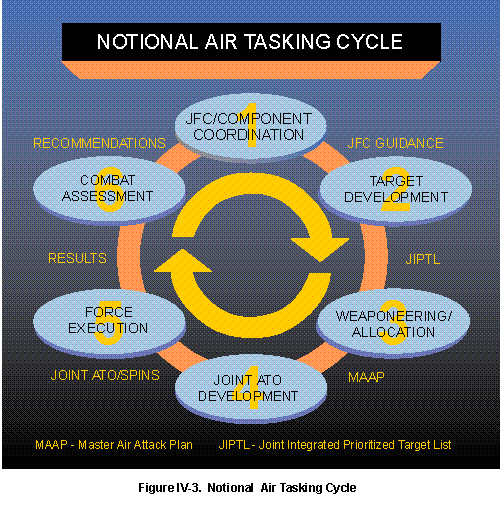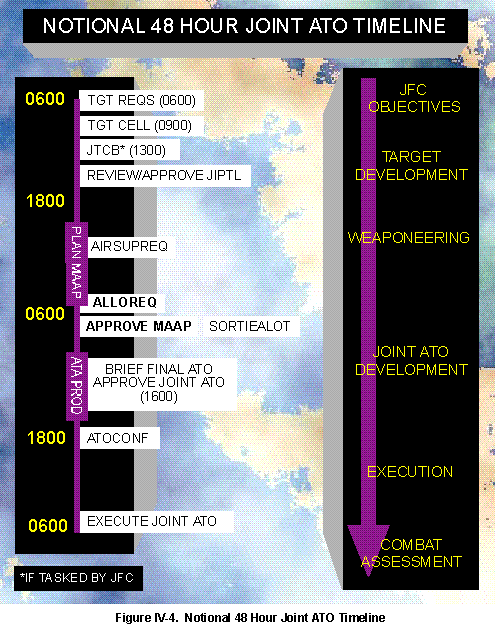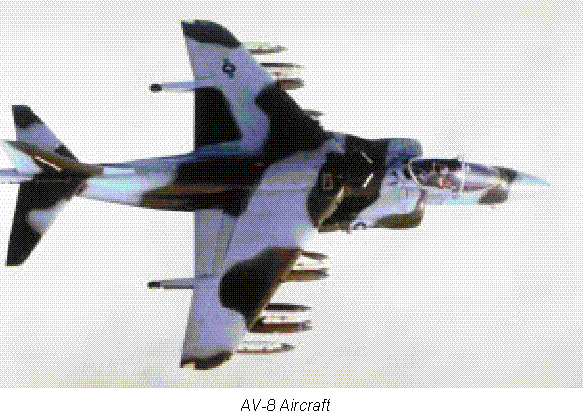
TARGETING AND TASKING FOR
JOINT AIR OPERATIONS
|
"The outstanding military lesson of this campaign was the
continuous calculated application of air power, inherent in the
potentialities, of the Air Force, employed in the most intimate
tactical and logistical union with ground troops."
General Douglas MacArthur describing the Buna Campaign |
Targeting is the process of selecting targets and matching the appropriate response to them. It takes into account strategic and operational requirements and capabilities and the threat to friendly forces imposed by the adversary. Targeting occurs at all levels of command within a joint force and is performed at all levels by forces capable of attacking targets with both lethal and nonlethal disruptive and destructive means. Targeting is complicated by the requirement to deconflict duplicative targeting by different forces or different echelons within the same force and to synchronize the attack of those targets with other components of the joint force. An effective and efficient target development process and air tasking cycle are essential for the JFACC/JFC staff to plan and execute joint air operations. This joint targeting process should integrate capabilities and efforts of national, unified, joint force, and component commands, all of which possess varying capabilities and different requirements. The process is the same in war and MOOTW.
Targeting is a cyclical process (Figure IV-1), which begins with guidance and priorities issued by the JFC and continues with identification of requirements by components; the prioritization of these requirements; the acquisition of targets or target sets; the attack of targets by components; component and JFC assessment of the attacks; and continuing guidance from the JFC on future attacks.

Targeting mechanisms should exist at multiple levels. The National Command Authorities (NCA) or headquarters senior to JFCs may provide guidance, priorities, and targeting support to JFCs. Joint force components identify requirements, nominate targets that are outside their AOs or exceed the capabilities of organic and supporting assets (based on the JFC's air apportionment decision), and conduct execution planning. After the JFC makes the targeting and air apportionment decisions, components plan and execute assigned missions.
The JFC may establish and task an organization within the JFC staff to accomplish these broad targeting oversight functions or may delegate the responsibility to a subordinate commander (e.g., JFACC). Typically, the JFC organizes a Joint Targeting Coordination Board (JTCB). If the JFC so designates, a JTCB may be an integrating center to accomplish the broad targeting oversight functions, or a JFC level review mechanism. In either case, it needs to be a joint activity comprised of representatives from the staff, all components, and if required, their subordinate units.
- The JTCB may assist the JFC in developing or revising the targeting guidance and/or priorities. The JTCB maintains a macro-level view of the AOR/JOA and ensures targeting nominations are consistent with the JFC's campaign plan.
The JFACC/JFC staff develops a joint air operations plan that accomplishes the objectives directed by the JFC. Synchronization, integration, deconfliction, allocation of air capabilities/forces, and matching appropriate weapons against target vulnerabilities are essential targeting functions for the JFACC. Other components targeting requirements to support their assigned missions are provided to the JFC and JFACC via the target information report (TGTINFOREP). Therefore, targets scheduled for deliberate attack by component direct support air capabilities/forces should be included in the joint ATO,when appropriate, for deconfliction and coordination. All component commanders within the joint force should have a basic understanding of each component's mission and general concept of operations/ scheme of maneuver to support the JFC's campaign. Therefore, components should provide the JFACC a description of their direct support plan through the liaison elements within the JAOC. This basic understanding will allow for coordination and deconfliction of targeting efforts between each component and within the JFC staff and agencies. Figure IV-2 details the JFACC/JFC staff targeting responsibilities.

4. The Joint Air Tasking Cycle
A joint air tasking cycle is used to provide for the efficient and effective employment of the joint air capabilities/ forces made available. The cycle (Figure IV-3) provides a repetitive process for the planning, coordination, allocation, and tasking of joint air missions/sorties, within the guidance of the JFC. The cycle accommodates changing tactical situations or JFC guidance, as well as requests for support from other component commanders. The joint air tasking cycle is an analytical, systematic approach that focuses targeting efforts on supporting operational requirements. Much of the day-to-day joint air tasking cycle is conducted through an interrelated series of information exchanges (through designated component liaison officers and/or messages), which provide a means of requesting and scheduling joint air missions. Note: A timely joint ATO is critical--other joint force components conduct their planning and operations based on a prompt, executable joint ATO, and are dependent on its information.

There are usually three joint ATOs at any time: (1) the joint ATO in execution (today's plan), (2) the joint ATO in production (tomorrow's plan), and (3) the joint ATO in planning (the following day's plan). The joint air tasking cycle begins with the JFC's air apportionment process and culminates with the combat assessment of previous missions/sorties. Figure IV-4 is a notional joint air tasking timeline, which may be modified to fit the particular situation.

The full joint ATO cycle from JFC guidance to the start of joint ATO execution is dependent on the JFC's procedures. Notionally, this spans a 3072 hour period. Each actual joint ATO period usually covers a 24-hour period (0600-0600 for illustrative purposes in this document). The precise timeframes for the joint air tasking cycle must be specified in the JFC's operation plans or the JFACC's joint air operations plan.
The execution phase of the joint air tasking cycle will notionally consist of 24-hour periods with start and end times as specified by joint air operations plans. The joint ATO embodies JFC objectives and intent in a joint air tasking directive. The joint ATO matches specific targets compiled by the JFACC/JFC staff with the capabilities/forces made available to the JFACC for the given joint ATO day.
The joint ATO phases depicted (Figure IV-3) are related to the targeting cycle. The approach is the same, a systematic process that matches available capabilities/forces with targets to achieve operational objectives. The number of ATO phases may vary based on theater and contingency requirements. Prior to the JFC and component commander's meeting, the JFACC meets with senior component liaisons and the JFACC staff to develop recommendations on joint air strategy and apportionment for future operations. (The use of the term "meeting" is notional; other methods of information exchange could also be used.) This meeting may review JFC objectives and guidance; analyze results of joint force operations and consider changes to planned or ongoing joint air operations; review adversary capabilities and courses of action, centers of gravity, decisive points, critical areas, and key targets; develop and recommend updates to the joint target list (JTL); and assess joint air capabilities for future operations to meet JFC objectives. The JFACC provides objectives and guidance to the staff for joint air operations to support the JFC's intent, recommends broad target categories that support the JFC's objectives, reviews joint force air capabilities/forces to achieve assigned tasks, refines requirements for capabilities/forces from other components, and after consulting with the other component commanders or their representatives, formulates an air apportionment recommendation for presentation to the JFC. Examples of air apportionment categories include, but are not limited to, strategic attack, interdiction, counterair, maritime support, and close air support.
The JFC consults often with his component commanders to assess the results of the warfighting effort and to discuss the strategic direction and future operation plans. This provides component commanders an opportunity to introduce recommendations, support requirements, and state their ability to support other components. The JFC provides broad guidance- and objectives and his vision of what constitutes military success. The JFC also defines the intent of the operation or campaign and sets priorities. The JFC's guidance and objectives will identify targeting priorities, JTL/JIPTL planning guidance, procedures, appropriate maneuver and movement control, joint fire support coordinating measures, ROE, and what defines component direct support sorties. This guidance will also include the JFC's air apportionment decision.

- The culmination of the joint air target development process occurs when specific targets are approved and included in the joint ATO and assigned to C/F made available for joint air operations.
- Allocation (Air). Following the JFC air apportionment decision, the JFACC/JFC staff translates that decision into total number of sorties by aircraft or weapon type available for each operation/task they support. On the basis of the JFC's air apportionment decision, internal requirements, and air support request (AIRSUPREQ) messages, each air capable component prepares an allocation request (ALLOREQ) message for transmission to the JFACC/JFC staff (normally not less than 24 hours prior to the air tasking day). ALLOREQ messages report:
- excess sorties not required by the air capable component and available for taskings by the JFACC/JFC staff, and:
- request for additional air support beyond the capability of the air capable component.
- After the MAAP is approved by the JFACC (JFC under the JFC staff option), detailed preparations continue by Combat Plans section on the joint ATO, SPINS, and the ACO (provided by the ACA). JFC and JFACC guidance, target worksheets, the MAAP, and component requirements are used to finalize the ATO/SPINS/ACO. Components may submit critical changes to target requests and asset availability during this final phase of joint ATO development. The ACA and AADC instructions must be provided in sufficient detail to allow components to plan and execute all missions tasked in the joint ATO. These directions must enable combat operations without undue restrictions, balancing combat effectiveness with the safe, orderly, and expeditious use of airspace. ACA instructions must provide for quick coordination of task assignment or reassignment. The AADC must direct aircraft identification and engagement procedures and ROE that are appropriate to the nature of the threat. ACA and AADC instructions should also consider the volume of friendly air traffic, friendly air defense requirements, IFF technology, weather, and enemy capabilities. ACA and AADC instructions are contained in monthly, weekly, and daily SPINS, and also in the ACO that is updated as frequently as required. The joint ATO, ACO, and SPINS provide operational and tactical direction at appropriate levels of detail. The level of detail should be very explicit when forces operate from different bases and multi-component and/or composite missions are tasked. By contrast, less detail is required when missions are tasked to a single component or base. See Joint Pub 3-52, "Doctrine for Joint Airspace Control in the Combat Zone," for further discussion.
- Allotment. The JAOC reviews each air capable component's allocation decision/ALLOREQ message and may prepare a sortie allotment (SORTIEALOT) message back to the components as required, in accordance with established operations plans guideline. If SORTIEALOT messages are not used, the JAOC can pass the information normally contained in the SORTIEALOT by other means (e.g., contingency theater automated planning system (CTAPS), through component liaisons). The SORTIEALOT message confirms (and where necessary modifies) the ALLOREQ and provides general guidance for planning joint air operations. The SORTIEALOT addresses three basic requirements:
- Approval/disapproval of component requests and allotment of other component's excess sorties to fill the approved air support requests, or other requirements for the joint force.
- Revisions to mission data for component air support requests, such as a changed mission priority or time on target. This is usually the result of coordination between the component and the JAOC staff

The JFC may give the JFACC the authority to redirect joint air operations. The affected component commander must approve all requests for redirection of direct support air assets. Affected component commanders will be notified by the JFACC upon redirection of joint sorties previously allocated in the joint ATO for support of component operations. Aircraft or other capabilities/forces not apportioned for tasking, but included in the ATO for coordination purposes, will be redirected only with the approval of the respective component commander or designated senior JAOC liaison officer. Components execute the joint ATO as tasked and recommend changes to the JAOC as appropriate, given emerging JFC and component requirements.
- During execution, the JAOC is the central agency for revising the tasking of joint air capabilities/forces. It is also charged with coordinating and deconflicting those changes with the appropriate control agencies or components.
- Due to battlefield dynamics, the JFACC/JFC may be required to make changes to the planned joint air operations during execution. The JFACC/JFC will notify the affected component commanders, as appropriate.
- During execution, the JFACC/JFC staff will normally be responsible for retargeting missions apportioned and allocated to support the joint force as a whole, to respond to moving targets or changing priorities. Ground or airborne command and control platform mission commanders may be delegated the authority from the JFACC (under the same conditions outlined above) to redirect sorties/missions made available to higher priority targets as necessary. It is essential, however, that the JAOC (Combat Operations Section) be notified of all redirected missions.
The JFACC/JFC staff is responsible for planning and activating all validated joint air communications links that support the JFC's mission and allow accomplishment of the JFC directives. The ability to exchange information via reliable secure communications with the JFC, joint force staff, and component commanders is key to the successful integration of the joint air effort. Planning must address the following areas:
Planning for all information exchange requirements and procedures must consider emission control requirements and operations security.
The best mix of computer aided systems must be available for data transmission. The JAOC and liaison officers depend on secure, reliable communications and data exchange equipment in order to respond to joint force requirements.
- Information such as ALLOREQs and SORTIEALOT are normally exchanged through US message text formats (USMTF). More specific guidance for USMTF is contained in Joint Pub 3-56.24, "Tactical Command and Control Planning Guidance and Procedures for Joint Operations--Joint Interface Operational Procedure--Message Text Formats," which specifies information exchange procedures for use within a joint force. Specific instructions and formats for preparing the MTFs are contained in the Joint User Handbook for Message Text Formats (JUH-MTF).